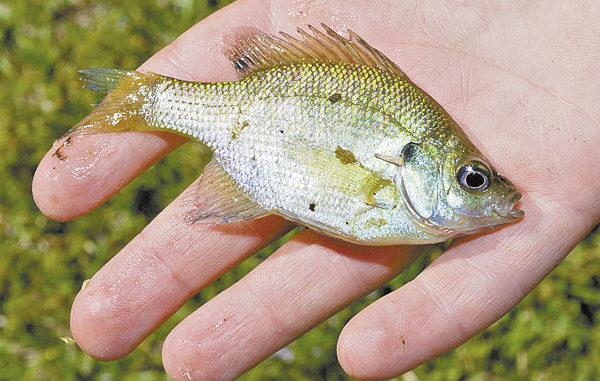
The quest for trophies in modern hunting and fishing is unquenchable. More and more deer hunters put up high fences to segregate the animals under their control from surrounding populations and then buy trophy bucks to upgrade the “quality” of their herd. If you can’t get a trophy any other way — well, you just grow your own.
The fishing equivalent of this is the construction of one’s own private lake or pond, and stocking it with Florida-strain bass. Originally native to the Florida peninsula and southern Georgia, this subspecies, or strain, of bass grows to larger sizes than do northern largemouths, those found everywhere else in the United States.
Inevitably, when anglers make the decision to stock Florida bass, they also stock what are known in the fish hatchery trade as coppernose bluegills. Officially known to biologists as eastern bluegills, coppernose bluegills are touted by private hatchery operators as growing faster and larger than bluegills native to other regions of the country.
Some debate exists as to whether stocking coppernose bluegills outside of their native range is a productive practice, both because they may not be the superfish that they are touted to be and because they may not survive cold weather as well as native bluegills.
If they out-compete natives for food and nest space, but can’t survive low water temperatures as well as natives, their stocking could have a negative effect on fish populations. The two are also subspecies within the same species, and will easily hybridize. It isn’t fully known whether hybrids will show superior growth, reduced spawning ability or other traits such as lopsided male-to-female ratios.
Biologists in both Louisiana and Texas have conducted some research on the subject. In the late 1980s, a graduate student at LSU conducted lab studies in controlled indoor tanks and in outdoor ponds. He also monitored the effects of the stocking of coppernose bluegills in Lake Buhlow, a 263-acre lake near Pineville.
In the tanks, water temperatures were gradually lowered and then raised during the 200 days of the experiment. In this phase of the study, small coppernose bluegills showed serious stress and survival problems at temperatures as high as 49 degrees, a common Louisiana winter temperature.
When water temperature dropped below 54 degrees, coppernose bluegills stopped moving and feeding, and clustered near the bottom of their tank. Native bluegill continued to show normal behavior.
In the part of the study that focused on the effect of low temperature on growth, mixed results were gathered. In one lab study where coppernoses and natives were kept in separate tanks, natives outgrew the coppernoses. In the other study, where the two subspecies were mixed, coppernose bluegills grew faster than the natives did because they were very aggressive and out-competed the natives for food. This was especially true for males.
Data gathered from Lake Buhlow showed slightly slower growth rates for coppernose bluegills than for native bluegills. The analysis also showed that the percentage of coppernose bluegills in the population declined relative to natives as time passed after stocking.
The Texas Parks and Wildlife Department’s study looked at growth rates, survival and catchability of the two subspecies. Coppernose bluegills were stocked in ponds with native bluegills from West Texas and East Texas. Some of the ponds were stocked with bluegills only, and others were stocked with bluegills as well as largemouth bass, green sunfish, redear sunfish and threadfin shad to imitate a more natural fish population. All bluegills were tagged with tiny wire tags.
The researchers found that in all of the ponds of the study, coppernose bluegills grew larger than Texas bluegills. They were 27 percent larger by weight the first year and 34 percent larger by the end of the second year.
All three types of bluegills averaged larger in the ponds stocked with other fish species, probably because bass predation thinned them out and reduced competition for food and/or because the bass ate the smaller ones, increasing the average size of the bluegills left.
All three types averaged above the 6-inch keeper size by the end of the second year. Coppernose bluegill maintained their size lead through years 3 and 4, averaging 8.6 inches long, compared to 7.6 inches for east Texas bluegills and 7.4 inches for those from west Texas.
A difference in first year survival rates was noticed in the ponds with other fish present. The coppernose bluegills’ survival rate was 69 percent, compared with 45 percent for East Texas fish and 37 percent for West Texas bluegills. This may have been due to their faster growth rate making them larger and less susceptible to bass, or they may just have been better at avoiding predators.
In the catchability part of the study, each pond was fished two hours a day during the summer and fall. The same type of artificial bait was used in each pond.
In the ponds with other fish present, catch rates were about equal in both years. In the bluegill-only ponds, coppernose bluegills were slightly easier to catch the first year, perhaps because of their larger size. But they were much harder to catch than natives in the second year. Coppernose bluegill catches were half that of East Texas bluegills and one-third that of West Texas bluegills.
Jerald Horst is author of six books on fish and seafood, including the acclaimed Trout Masters: How Louisiana’s Best Anglers Catch the Lunkers. His latest book is The Louisiana Seafood Bible: Crabs.


